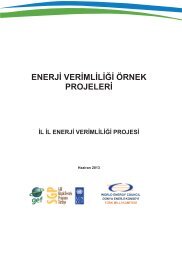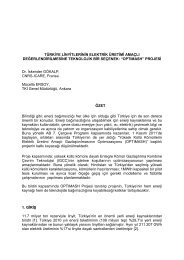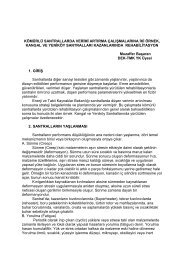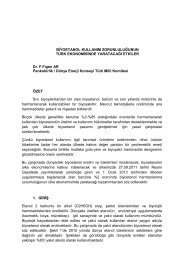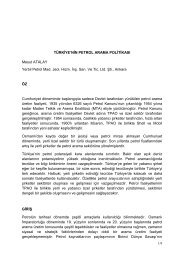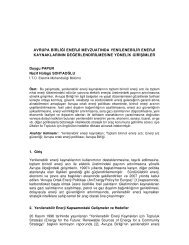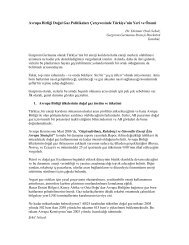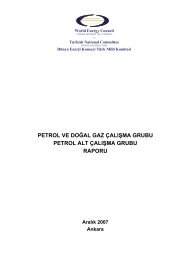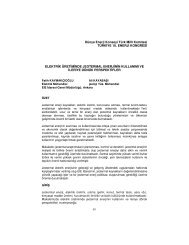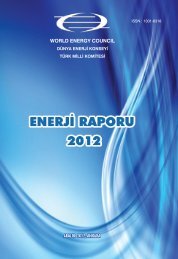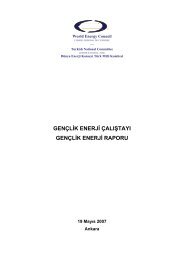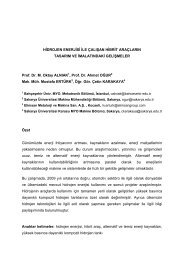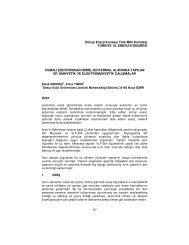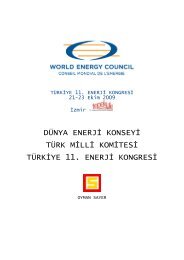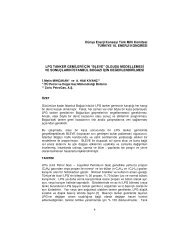Energy Efficiency A Recipe for Success – Executive Summary
Energy Efficiency
Energy Efficiency
- No tags were found...
You also want an ePaper? Increase the reach of your titles
YUMPU automatically turns print PDFs into web optimized ePapers that Google loves.
able energy <strong>for</strong> the<br />
<strong>Energy</strong> <strong>Efficiency</strong>: A<br />
<strong>Recipe</strong> <strong>for</strong> <strong>Success</strong> <strong>–</strong><br />
<strong>Executive</strong> <strong>Summary</strong><br />
World <strong>Energy</strong> Council
<strong>Energy</strong> <strong>Efficiency</strong>: A<br />
<strong>Recipe</strong> <strong>for</strong> <strong>Success</strong> -<br />
<strong>Executive</strong> <strong>Summary</strong><br />
Officers of the World <strong>Energy</strong> Council<br />
Pierre Gadonneix<br />
Chair<br />
Francisco Barnés de Castro<br />
Vice Chair, North America<br />
Norberto Franco de Medeiros<br />
Vice Chair, Latin America/Caribbean<br />
Richard Drouin<br />
Vice Chair, Montréal Congress 2010<br />
C.P. Jain<br />
Chair, Studies Committee<br />
Younghoon David Kim<br />
Vice Chair, Asia Pacific & South Asia<br />
Jorge Ferioli<br />
Chair, Programme Committee<br />
<strong>Energy</strong> <strong>Efficiency</strong>: A <strong>Recipe</strong> <strong>for</strong> <strong>Success</strong> <strong>–</strong> <strong>Executive</strong><br />
<strong>Summary</strong><strong>–</strong> <strong>Executive</strong> <strong>Summary</strong><br />
World <strong>Energy</strong> Council<br />
Copyright ©2010World <strong>Energy</strong> Council<br />
All rights reserved. All or part of this publication may be used or<br />
reproduced as long as the following citation is included on each<br />
copy or transmission: „Used by permission of the World <strong>Energy</strong><br />
Council, London, www.worldenergy.org‟<br />
Published 2010 by:<br />
World <strong>Energy</strong> Council<br />
Regency House 1-4 Warwick Street<br />
London W1B 5LT United Kingdom<br />
ISBN: 978 0 946121 00 7<br />
Marie-José Nadeau<br />
Vice Chair, Communications & Outreach Committee<br />
Abubakar Sambo<br />
Vice Chair, Africa<br />
Johannes Teyssen<br />
Vice Chair, Europe<br />
Abbas Ali Naqi<br />
Vice Chair, Special Responsibility <strong>for</strong> Middle East &<br />
Gulf States<br />
Graham Ward, CBE<br />
Vice Chair, Finance<br />
Zhang Guobao<br />
Vice Chair, Asia<br />
Christoph Frei<br />
Secretary General
<strong>Energy</strong> <strong>Efficiency</strong>: A <strong>Recipe</strong> <strong>for</strong> <strong>Success</strong> <strong>–</strong> <strong>Executive</strong> <strong>Summary</strong> World <strong>Energy</strong> Council<br />
1<br />
Contents<br />
Introduction 2<br />
Evaluation of <strong>Energy</strong> <strong>Efficiency</strong> Policies and<br />
Measures 2<br />
<strong>Energy</strong> <strong>Efficiency</strong> and CO 2 Trends 5<br />
Developments in <strong>Energy</strong> <strong>Efficiency</strong> Policies<br />
and Measures 7<br />
Recommendations 11
<strong>Energy</strong> <strong>Efficiency</strong>: A <strong>Recipe</strong> <strong>for</strong> <strong>Success</strong> <strong>–</strong> <strong>Executive</strong> <strong>Summary</strong> World <strong>Energy</strong> Council<br />
2<br />
<strong>Energy</strong> efficiency: What is new since 2007? What do<br />
the trends show? What energy efficiency measures<br />
produce the best results? Which measures are most<br />
cost effective?<br />
Introduction<br />
<strong>Energy</strong> efficiency is “a low hanging fruit” on the<br />
“energy tree” which can help address a number<br />
of objectives at the same time and at a low or<br />
negative cost: security of supply, environmental<br />
impacts, competitiveness, balance of trade,<br />
investment requirements, social aspects and<br />
others. Despite its significant potential <strong>for</strong> energy<br />
savings, energy efficiency is still far from realising<br />
this potential. Why? There is no single answer to<br />
this question. A meaningful response requires<br />
major research and an analytical ef<strong>for</strong>t.<br />
WEC works together with ADEME (Agency <strong>for</strong><br />
Environment and <strong>Energy</strong> <strong>Efficiency</strong>, France) and<br />
with technical assistance from ENERDATA<br />
(France) collecting energy efficiency indicators in<br />
countries around the world and conducting<br />
surveys of energy efficiency policies and<br />
measures. Analysis of the interaction between<br />
energy efficiency policies and energy efficiency<br />
per<strong>for</strong>mance of economies accounts <strong>for</strong> a<br />
significant part of the ef<strong>for</strong>t. The databases of<br />
energy efficiency indicators and energy efficiency<br />
policies and measures on the WEC website 1<br />
provide data and a comparative index of different<br />
countries‟ per<strong>for</strong>mance in a variety of energy<br />
efficiency areas.<br />
The 2010 report presents and evaluates energy<br />
efficiency policies and trends in about 90<br />
countries around the world to find answers to the<br />
following questions:<br />
1<br />
http://www.worldenergy.org/work_programme/technical_pr<br />
ogramme/technical_committees/energy_efficiency_policies_<br />
and_indicators/default.asp<br />
What is the importance of energy<br />
efficiency measures?<br />
What are the priorities?<br />
What are the trends?<br />
What are the results?<br />
Evaluation of <strong>Energy</strong><br />
<strong>Efficiency</strong> Policies and<br />
Measures<br />
This evaluation covers the impact of selected<br />
energy efficiency policy measures around the<br />
world based on a comprehensive global survey.<br />
The evaluation also draws on six in-depth case<br />
studies prepared by international experts. The<br />
following measures were selected <strong>for</strong> in-depth<br />
case studies, because they have emerged as<br />
new concerns or areas <strong>for</strong> political action <strong>for</strong><br />
policy decision-makers 2 :<br />
1. Innovative communication/in<strong>for</strong>mation<br />
tools <strong>for</strong> utilities and/or energy agencies.<br />
2. Good practices in the public sector.<br />
3. <strong>Success</strong>ful financial tools <strong>for</strong> households.<br />
2 The following measures have already been evaluated<br />
in the previous reports: building codes, energy audits,<br />
labelling and standards of electrical appliances,<br />
incentives <strong>for</strong> cars, voluntary/sectoral agreements,<br />
local energy in<strong>for</strong>mation centres, new energy efficiency<br />
financing schemes, packages of P&M‟s., <strong>Energy</strong><br />
Service Companies (ESCO‟s), energy efficiency<br />
obligation <strong>for</strong> energy utilities, measures <strong>for</strong> solar water<br />
heaters.
<strong>Energy</strong> <strong>Efficiency</strong>: A <strong>Recipe</strong> <strong>for</strong> <strong>Success</strong> <strong>–</strong> <strong>Executive</strong> <strong>Summary</strong> World <strong>Energy</strong> Council<br />
3<br />
4. <strong>Energy</strong> efficiency measures <strong>for</strong> low<br />
income households.<br />
5. Obligation of energy savings (white<br />
certificates).<br />
6. Regulation and compliance.<br />
Each of the experts prepared a core report with<br />
examples of country experiences (“country case<br />
studies”) 3 .<br />
The survey 4 of energy efficiency policy measures<br />
<strong>for</strong>ms another section of the report and covers a<br />
total of 88 countries:<br />
‣ 34 from Europe: 27 countries from the<br />
European Union (EU), and Croatia, Iceland,<br />
Norway, Russia, Serbia, Switzerland and<br />
Turkey.<br />
‣ 15 from the Americas: Argentina, Bolivia,<br />
Brazil, Canada, Chile, Colombia, Costa<br />
Rica, El Salvador, Mexico, Paraguay, Peru,<br />
Uruguay, USA and Venezuela.<br />
‣ 17 from Asia and the Pacific: Australia,<br />
China, Hong Kong China, India, Indonesia,<br />
Japan, Malaysia, Mongolia, Myanmar, New<br />
Zealand, Philippines, Republic of Korea,<br />
Singapore, Sri Lanka, Thailand and<br />
Vietnam.<br />
‣ 15 from Africa: Algeria, Botswana, Cote<br />
d‟Ivoire, Egypt, Ethiopia, Ghana, Guinea,<br />
Guinea Bissau, Kenya, Mali, Mauritania,<br />
Morocco, Nigeria, Senegal, South Africa and<br />
Tunisia.<br />
‣ 7 from the Middle East: Iran, Israel, Jordan,<br />
Kuwait, Lebanon, Syria and Yemen.<br />
The surveyed countries together represent about<br />
90% of the world energy consumption (100% <strong>for</strong><br />
North America and Western Europe, 95% <strong>for</strong><br />
Asia, 90% <strong>for</strong> Latin America, 75% <strong>for</strong> Africa and<br />
50% <strong>for</strong> the Middle East).<br />
Almost 70% of the surveyed countries do not<br />
belong to OECD. There is still room <strong>for</strong><br />
improvement in the coverage of Africa but more<br />
countries are included this time (15 compared to<br />
12 in 2007). The coverage of Latin America is<br />
considerably better than in the previous report<br />
(13 compared to 7). Among the 29 OECD<br />
countries, 7 countries are outside Europe.<br />
The survey covers institutional aspects, as well<br />
as existing regulations and financial measures. It<br />
also covers with a greater focus the selected<br />
energy efficiency policy measures mentioned<br />
above. The measures considered in the survey<br />
are organised as follows 5 :<br />
‣ Institutions and Programmes<br />
Institutions: agencies (national, regional<br />
and local), Ministry department;<br />
National programmes of energy<br />
efficiency with quantitative targets and<br />
laws;<br />
‣ Regulations<br />
Minimum efficiency standards and<br />
labels <strong>for</strong> electrical appliances<br />
(refrigerators, washing machines, AC,<br />
lamps, water heaters, motors), cars and<br />
buildings (new and existing).<br />
3 The full reports are available on the WEC web site<br />
4 The survey is based on a questionnaire designed by<br />
ADEME and Enerdata and sent in 2009 to all WEC<br />
Member Committees and additional contacts from the<br />
ADEME network of energy efficiency agencies in the<br />
EU 25, North Africa, and some OECD countries. In<br />
total 100 countries were contacted, 60 countries<br />
answered directly and 25 countries were completed by<br />
Enerdata from the previous survey of 2006 and from<br />
literature research.<br />
5 Measures to promote renewable energies and fuel<br />
substitution were not included. R&D activities, although<br />
important in the long term, are also excluded from the<br />
survey, as they are less important in developing<br />
countries.
4<br />
<strong>Energy</strong> <strong>Efficiency</strong>: A <strong>Recipe</strong> <strong>for</strong> <strong>Success</strong> <strong>–</strong> <strong>Executive</strong> <strong>Summary</strong> World <strong>Energy</strong> Council<br />
CO 2 emissions from energy use were 40%<br />
higher in 2008 than in 1990 at world level<br />
Other mandatory regulations <strong>for</strong><br />
designated consumers: energy<br />
managers, consumption reporting,<br />
saving and maintenance.<br />
Obligation of energy savings <strong>for</strong> energy<br />
companies at consumers‟ premises.<br />
‣ Financial measures<br />
Subsidies <strong>for</strong> audits by sector: industry,<br />
commercial, public, households, low<br />
income households, transport.<br />
Subsidies or soft loans i.e. loans with<br />
subsidised interest rates, <strong>for</strong> energy<br />
efficiency investment and equipment by<br />
sector.<br />
‣ Fiscal measures:<br />
Tax credits<br />
Accelerated depreciation<br />
Tax reduction <strong>for</strong> efficiency investment,<br />
by type of tax (import, VAT, purchase,<br />
annual car registration) and by type of<br />
equipment (appliances, cars, lamps,<br />
etc.).<br />
‣ Cross-cutting measures:<br />
Innovative communication tools.<br />
Voluntary agreements.<br />
The results of the survey are summarised in the<br />
report using different graphs, which show the<br />
degree of implementation of the measures in six<br />
world regions: Europe 6 , North America and<br />
OECD Asia & Pacific 7 , Latin America, Non OECD<br />
Asia, Africa and Middle East 8 . The results of the<br />
survey are also available in an interactive online<br />
data base 9 and can be queried by type of<br />
measure, target (i.e. sector, type of appliance)<br />
and country.<br />
Although energy pricing is an important<br />
component of energy efficiency policies, it was<br />
not addressed in the survey, as there are a<br />
number of different international data bases that<br />
monitor price levels and trends. 10<br />
Many energy importing non-OECD countries are<br />
protecting their consumers from increases in the<br />
oil price by maintaining subsidised prices <strong>for</strong><br />
some fuels. This has a negative impact on public<br />
finance, which became especially clear in the<br />
recent years with the soaring oil price. Subsidies<br />
generally act as a significant disincentive <strong>for</strong><br />
energy efficiency investments and limit the scope<br />
and profitability of energy service companies<br />
(ESCOs).<br />
<strong>Energy</strong> producing countries often maintain very<br />
low domestic prices, which lead to intensive<br />
energy use reflected in their high and rising<br />
energy intensities. A reduction in subsidies could<br />
save energy which could be sold at a much<br />
higher price on the international market and thus<br />
bring significant benefits to economies.<br />
Adequate pricing means establishing consumer<br />
energy prices that reflect the cost of energy<br />
supply, i.e. the long-term marginal cost <strong>for</strong><br />
electricity and the long-term price of oil products<br />
on international markets <strong>for</strong> fossil fuels. Taxation<br />
of energy may further contribute to internalising<br />
the externalities (such as social cost, opportunity<br />
cost and security of supply cost) in the energy<br />
price.<br />
6 Including Russia<br />
7 USA, Canada, Japan, Australia;, South Korea, New<br />
Zealand.<br />
8 The percentages shown in the different graphs only<br />
apply to the countries that have responded to the<br />
survey: they are not an exact average of each region,<br />
except <strong>for</strong> Europe where the rate of answers was quite<br />
good. The countries are in addition not weighted<br />
according to their energy consumption.<br />
9 www.wec-policies.enerdata.eu<br />
10 For instance GTZ monitors motor fuel prices <strong>for</strong> all<br />
countries in the world in its publication: “International<br />
Fuel Prices”, www.gtz.de/fuelprices ; (last update<br />
2009). IEA provide quarterly energy prices <strong>for</strong> all<br />
OECD countries and a selection of non OECD<br />
countries.
<strong>Energy</strong> <strong>Efficiency</strong>: A <strong>Recipe</strong> <strong>for</strong> <strong>Success</strong> <strong>–</strong> <strong>Executive</strong> <strong>Summary</strong> World <strong>Energy</strong> Council<br />
5<br />
Although most energy planners agree with such<br />
objectives, they often face reluctance and<br />
opposition from decision-makers outside the<br />
energy sector, who fear public resistance and the<br />
impact of energy price corrections on the<br />
consumer price index. Moreover, energy is a<br />
basic need and its af<strong>for</strong>dability is essential,<br />
especially <strong>for</strong> low-income households. This<br />
makes actual price adjustments very slow or nonexistent<br />
in many developing countries, especially<br />
in the household sector.<br />
<strong>Energy</strong> <strong>Efficiency</strong> and CO 2<br />
Trends<br />
By reviewing energy efficiency trends and<br />
policies at world level, the present report aims to<br />
facilitate the exchange of in<strong>for</strong>mation and share<br />
experiences on energy efficiency measures<br />
among different countries around the world. It<br />
can help government decision-makers and<br />
analysts select appropriate and cost-effective<br />
measures <strong>for</strong> each sector, taking into account<br />
their national circumstances. Decision tools such<br />
as energy efficiency/CO 2 indicators are very<br />
useful <strong>for</strong> monitoring trends in energy use and<br />
CO 2 emissions and contribute to a better<br />
understanding of the impact of the measures<br />
implemented in each sector.<br />
<strong>Energy</strong> consumption has increased much<br />
slower than the GDP since 2004<br />
<strong>Energy</strong> consumption is growing less rapidly than<br />
the economic activity in all world regions, except<br />
the Middle East. This decreasing trend <strong>for</strong> the<br />
energy intensity (energy consumption per unit of<br />
GDP) accelerated since 2004 because of higher<br />
oil prices and the introduction of new policies:<br />
1.9% p.a between 2004 and 2008 compared to<br />
1.4% p.a. between 1990 and 2008.<br />
In 2009, because of the economic crisis, the<br />
trend development was generally slower except<br />
in North America and OECD Pacific. More than<br />
two thirds of the countries in the world have<br />
decreased their energy intensity, and 50% of<br />
them by more than 1% p.a. <strong>Energy</strong> productivity<br />
improved significantly, by more than 3% p.a. in<br />
30 countries.<br />
<strong>Energy</strong> productivity improvements since<br />
1990 have helped avoid consumption of<br />
3.6 Gtoe of primary energy and CO 2<br />
emissions of 8 Gtoe by 2008<br />
The reduction in the energy intensity between<br />
1990 and 2008 in most world regions resulted in<br />
large energy and CO 2 savings, estimated at<br />
3.6 Gtoe in 2008 and 8 Gtoe of CO 2 emissions.<br />
Significant potential <strong>for</strong> further energy<br />
intensity reductions in many world<br />
regions<br />
Large differences exist between world regions in<br />
their energy intensity levels, even after<br />
conversion of GDP to purchasing power parities:<br />
the energy intensity in the CIS, <strong>for</strong> example, is<br />
2.7 times higher than in Europe, the region with<br />
the lowest value; and about twice as much in<br />
China, The Middle East and Africa. In North<br />
America, India and other Asia the intensity is<br />
about 50% above the European value. This<br />
shows significant potential <strong>for</strong> reduction in the<br />
future. OECD Asia and Pacific and Latin America<br />
however are only 10% above Europe.<br />
Apart from Europe, energy productivity gains<br />
are greater <strong>for</strong> final consumers, by 20% at<br />
world level<br />
The increasing use of electricity by final<br />
consumers has resulted in greater losses in<br />
power generation, as most of the electricity is<br />
produced from thermal or nuclear power plants.<br />
In Europe, there is an opposite trend: the primary<br />
energy intensity is decreasing more rapidly than<br />
the final energy intensity due to the increasing<br />
share of gas turbine combined cycle, wind and<br />
cogeneration in power production.<br />
<strong>Energy</strong> efficiency of thermal power<br />
generation is still low in most emerging<br />
and developing countries, resulting in a<br />
significant potential of energy savings
6<br />
<strong>Energy</strong> <strong>Efficiency</strong>: A <strong>Recipe</strong> <strong>for</strong> <strong>Success</strong> <strong>–</strong> <strong>Executive</strong> <strong>Summary</strong> World <strong>Energy</strong> Council<br />
<strong>Energy</strong> efficiency of thermal power generation<br />
improved only moderately, by 2.6% since 1990 at<br />
world level. The world average efficiency is<br />
presently 35%, which is far from the EU average<br />
(40%). If all world regions had the same<br />
per<strong>for</strong>mance as the EU average, 450 Mtoe of fuel<br />
would have been saved in 2008 alone, avoiding<br />
1.3 Gtoe of CO 2 emissions.<br />
A convergence of per<strong>for</strong>mance in industry<br />
because of globalisation<br />
The specific energy consumption of energy<br />
intensive industries (e.g. steel, cement, paper) is<br />
converging and decreasing rapidly in regions with<br />
the worst per<strong>for</strong>mances because of globalisation<br />
of these industries. The best world practices are<br />
no longer found in the most developed countries.<br />
The specific consumption of new cars is<br />
decreasing consistently thanks to various<br />
policy measures<br />
In EU countries and Japan, the specific<br />
consumption of new cars has decreased<br />
consistently since 1995 (agreement with car<br />
manufacturers followed more recently by<br />
mandatory labels and a greening of taxes on<br />
vehicles <strong>for</strong> the EU and top-runner programme in<br />
Japan) the reduction has been slower in the US.<br />
Increased appliance ownership driven by<br />
higher income has partially offset the<br />
effect of energy efficiency policies<br />
In the residential sector, the average electricity<br />
consumption per household 11 did not really slow<br />
down, despite implementation of strong policies.<br />
Rising household income has led to increased<br />
ownership of large appliances (cooling and<br />
washing appliances), to a rapid diffusion of new<br />
appliances (e.g. air conditioning, ICT<br />
appliances 12 ) and devices. The growing use of<br />
stand-by mode in an increasing number of<br />
applications has offset the impact of the<br />
penetration of more efficient appliances.<br />
The growth in electricity consumption per<br />
household is much slower in Europe and North<br />
America (below 1% p.a.) than in emerging<br />
countries, because of stronger policies and<br />
saturation in appliance ownership.<br />
Electricity consumption grows faster than<br />
activities in services<br />
In the service sector, the electricity consumption<br />
is growing much faster than the value added in<br />
almost all regions with the growing use of air<br />
conditioning and office appliances; there has<br />
been a slower development in industrialised<br />
countries since 2000.<br />
CO 2 emissions from energy use were 40%<br />
higher in 2008 than in 1990 at world level<br />
CO 2 emissions from energy use have increased<br />
in all regions since 1990, except in the CIS and<br />
Europe: where they were 40% lower in 2008 than<br />
in 1990 at world level. The growth is very rapid in<br />
non-OECD Asia, in particular in China and India,<br />
and in the Middle East where emissions have<br />
multiplied by a factor of 2.6 since 1990). In 2008<br />
in Europe, climate change policies have helped<br />
to bring CO 2 emissions from energy use down to<br />
their 1990 level.<br />
Because of the growing role of emerging<br />
countries with lower levels of CO 2 emissions per<br />
capita, world CO 2 emissions per capita are only<br />
slightly increasing: they stood at 4.2 t CO 2 /capita<br />
in 2008 compared to 3.9 t in 1990 (+9%).<br />
11 Excluding heating in OECD countries to have<br />
comparable consumption.<br />
12 ICT: In<strong>for</strong>mation and Communication Technologies:<br />
TV, PC‟s, modems, etc…
<strong>Energy</strong> <strong>Efficiency</strong>: A <strong>Recipe</strong> <strong>for</strong> <strong>Success</strong> <strong>–</strong> <strong>Executive</strong> <strong>Summary</strong> World <strong>Energy</strong> Council<br />
7<br />
In most countries and at world level, the<br />
reduction in CO 2 emissions per unit of GDP was<br />
driven primarily by energy productivity<br />
improvements (i.e. mostly energy efficiency) and<br />
not by fuel substitution.<br />
Developments in <strong>Energy</strong><br />
<strong>Efficiency</strong> Policies and<br />
Measures 13<br />
The trends in energy and CO 2 indicators result<br />
from various factors, including changes in energy<br />
prices and energy efficiency policy measures.<br />
The report conducted a comparison of the<br />
countries experiences in the implementation of<br />
energy efficiency policies. This evaluation helped<br />
develop the most effective and innovative policy<br />
measures implemented. It also reviewed the<br />
experience with specific measures and sectors<br />
through several policy case studies: energy<br />
savings obligations; role and importance of<br />
compliance <strong>for</strong> regulations; good practices in the<br />
public sector; evaluation of smart meters policies;<br />
energy efficiency measures <strong>for</strong> low income<br />
households;<br />
innovative<br />
communication/in<strong>for</strong>mation tools.<br />
About two-thirds of the countries<br />
surveyed have a national energy<br />
efficiency agency and programmes with<br />
quantitative targets<br />
About two thirds of the countries surveyed (i.e. 60<br />
countries) have a national energy efficiency<br />
agency. In recent years there has been an<br />
increase in local and regional agencies all over<br />
the world (about 1300 local and regional<br />
agencies according to the survey, of which there<br />
are approximately 900 in Europe).<br />
These agencies at all levels (national, regional or<br />
local) are necessary to design, coordinate,<br />
implement and evaluate programmes and<br />
measures by introducing the requisite technical<br />
skill. National agencies can also play leading<br />
roles in negotiating sectoral agreements with<br />
equipment producers and financial packages <strong>for</strong><br />
energy efficiency with national banks,<br />
international financing institutions or donors.<br />
In addition, many countries are adopting energy<br />
efficiency laws. This should provide a favourable<br />
and long lasting context <strong>for</strong> energy efficiency<br />
policies and avoid the negative effect of “stop and<br />
start” actions.<br />
Increasingly more countries with quantitative<br />
targets <strong>for</strong> energy efficiency improvement<br />
About two thirds of the surveyed countries have<br />
set up official overall or sectoral quantitative<br />
targets <strong>for</strong> energy efficiency improvement. This<br />
represents a significant increase compared to the<br />
previous survey, especially in Europe where now<br />
around 90% of countries have a target compared<br />
to 55% in 2007. In addition, many countries have<br />
multiple targets. Final consumers are more often<br />
targeted in Europe than in the rest of the world,<br />
while other regions give a priority to targets on<br />
the primary consumption. In most regions, targets<br />
are most often expressed in terms of rate of<br />
energy efficiency improvements or energy<br />
savings; there are fewer objectives on energy<br />
intensity reductions, which used to be the<br />
dominant way to set up energy efficiency targets.<br />
Increasingly these targets are combined with<br />
yearly monitoring requirements.<br />
More countries have introduced energy<br />
efficiency labels or MEPS 14 and the<br />
number of products covered is increasing<br />
13 The results of the survey and the policy case studies<br />
can be found on the WEC web site at<br />
http://www.worldenergy.org/work_programme/technical<br />
_programme/technical_committees/energy_efficiency_<br />
policies_and_indicators/default.asp.<br />
Labelling of appliances is the main measure<br />
which has been implemented and now in about<br />
60 countries according to the survey. Usually the<br />
14 Minimum <strong>Energy</strong> Per<strong>for</strong>mance Standards
8<br />
<strong>Energy</strong> <strong>Efficiency</strong>: A <strong>Recipe</strong> <strong>for</strong> <strong>Success</strong> <strong>–</strong> <strong>Executive</strong> <strong>Summary</strong> World <strong>Energy</strong> Council<br />
refrigerator is the first appliance to be labelled.<br />
Many countries have adopted MEPS <strong>for</strong> lamps to<br />
phase out incandescent lamps. Mandatory use of<br />
solar water heaters is now implemented in<br />
several countries, <strong>for</strong> example in Spain.<br />
Building regulations are extended to existing<br />
buildings to enlarge their potential impacts. For<br />
instance, the EU building directive imposes<br />
energy efficiency certificates <strong>for</strong> existing buildings<br />
(equivalent to an energy efficiency label), each<br />
time there is a change of occupant or a sale.<br />
These certificates enable the buyer to obtain<br />
in<strong>for</strong>mation about the energy consumption of the<br />
property they are going to buy or rent. In addition<br />
an update of the EU directive introduces<br />
mandatory energy standards <strong>for</strong> existing<br />
buildings undergoing renovations.<br />
Economic incentives rely more and more<br />
on subsidies than on fiscal incentives<br />
Two thirds of countries have subsidy schemes.<br />
Fiscal measures are mainly used in OECD<br />
countries where the tax collection system is more<br />
developed and revenues from tax higher.<br />
Economic incentives should be targeted to limit<br />
the number of consumers that can benefit from<br />
them (e.g. low income households, tenants); in<br />
addition, they should be also restricted to certain<br />
types of investment (from a selected list of<br />
equipment), with a long payback time but high<br />
efficiency gains (e.g. renewables, co-generation)<br />
or to innovative technologies (demonstration or<br />
pilot investments). Solar water heaters and CFL<br />
are the main appliances to earn financial or fiscal<br />
incentives.<br />
Economic incentives are also used to promote<br />
the quality of energy efficienct equipment and<br />
services: in that case, the incentives only apply to<br />
products and services that have been certified or<br />
accredited by a public authority, generally the<br />
energy efficiency agency.<br />
Tax reductions on energy efficient equipment or<br />
investments have been introduced in many<br />
countries and almost equally in all regions: they<br />
are in <strong>for</strong>ce in about 30% of the surveyed<br />
countries. The compact fluorescent lamp is the<br />
most common piece of equipment to which this<br />
measure applies outside the OECD. In some<br />
European countries, lower VAT level is used on<br />
labour costs to reduce the investment costs of<br />
buildings renovation. Another innovative way to<br />
promote investment in energy efficiency and CO 2<br />
reduction is to offer tax concessions to<br />
companies that make concrete commitments on<br />
energy efficiency gains/CO 2 reduction, and meet<br />
their target.<br />
Green tax on cars<br />
Several countries are now introducing an<br />
innovative approach by using green taxes <strong>for</strong><br />
cars, in which the amount of the tax is function of<br />
the CO 2 emissions or energy efficiency of the<br />
cars 15 . This applies to purchase tax as well as the<br />
annual tax. Such taxes have been very effective<br />
in shifting demand towards less powerful and<br />
more efficient cars.<br />
<strong>Energy</strong> savings obligations <strong>for</strong> utilities: a<br />
promising market based instrument<br />
<strong>Energy</strong> savings obligations are used in Europe<br />
and South America (e.g. Brazil, Uruguay). There<br />
are considerable variations in the way they are<br />
applied and on whom the obligations are placed.<br />
These obligations have been a success and are<br />
expanding in those countries where they have<br />
been implemented. The obligations to date have<br />
been delivered mainly in the residential sector<br />
and have largely operated without significant<br />
15 France has introduced an innovative package<br />
combining a tax and subsidy scheme <strong>for</strong> new cars<br />
(known as “bonus malus”).
<strong>Energy</strong> <strong>Efficiency</strong>: A <strong>Recipe</strong> <strong>for</strong> <strong>Success</strong> <strong>–</strong> <strong>Executive</strong> <strong>Summary</strong> World <strong>Energy</strong> Council<br />
9<br />
trading of their energy savings (White<br />
Certificates) 16 .<br />
<strong>Energy</strong> savings obligations are attractive to<br />
governments because the cost is not met by<br />
them.<br />
<strong>Energy</strong> savings obligations could be an important<br />
policy option <strong>for</strong> developing countries as they<br />
offer a way <strong>for</strong> governments to tackle energy<br />
efficiency at a fairly modest increase of electricity<br />
customers‟ bills (1-2%). Countries just embarking<br />
in such obligations will need to establish potential<br />
savings <strong>for</strong> their own local circumstances,<br />
although many electrical end-uses are<br />
increasingly global (e.g. energy efficient lighting<br />
and appliances). These obligations could also be<br />
tied in with the Clean Development Mechanism<br />
(CDM).<br />
Role and importance of compliance <strong>for</strong><br />
regulations<br />
There is a trend to multiply the number of<br />
appliances, equipment or buildings with efficiency<br />
standards. However, to be effective these<br />
regulations need to be effectively implemented.<br />
This raises the problem of compliance. Poor<br />
compliance can have a long-term negative<br />
impact on energy efficiency strategies.<br />
Compliance comes at a cost but it is significantly<br />
lower than the benefits.<br />
Compliance is not a black and white issue.<br />
Programmes cannot easily be categorised as in<br />
non-compliance and thus the idea of ranking<br />
measures as optimal or sub-optimal compliance<br />
is more appropriate. All programme evaluations<br />
should include an analysis of compliance as a<br />
factor in determining overall impact and more<br />
analysis is needed as to why compliance is not<br />
being favourably implemented.<br />
There should be a healthier sharing of best<br />
practice on compliance methods. More capacity<br />
building initiatives are needed to improve the<br />
16 Certificates used <strong>for</strong> the trading of energy savings<br />
are known as “White Certificates”.<br />
development and implementation of compliance<br />
systems.<br />
Good practice in the public sector<br />
Opportunities to harness energy efficiency<br />
potential in the public sector are available in<br />
every country. As public sector activities reach<br />
across various end-use sectors there are always<br />
opportunities ranging from small-scale lighting<br />
retrofits to larger scale utility upgrades.<br />
Public money is being used to purchase products<br />
and services and build facilities: by integrating<br />
efficiency considerations into procurement<br />
processes public money can be more effective<br />
with higher long-term returns.<br />
The potential to learn from the experiences of<br />
other countries at different levels of governance<br />
is enormous and existing networks of public<br />
servants can provide instrumental support in this<br />
process. In addition to dissemination of<br />
experiences across national borders, learning<br />
opportunities are also available from one level of<br />
government to another.<br />
Programmes <strong>for</strong> low income households<br />
Measures <strong>for</strong> low income households on energy<br />
prices (e.g., social tariff, regulation), on<br />
household income (e.g., social benefits, direct<br />
financial aid) and on energy efficiency<br />
programmes should be seen as complementary.<br />
Measures related to energy efficiency need more<br />
time to reach households and get work done.<br />
The main funding source is usually the public<br />
authority in charge of the corresponding policy.<br />
But it may also be the utilities or energy suppliers<br />
through energy savings obligation schemes.<br />
Then the delivery mechanisms are designed to<br />
seek out the best compromise between fairness<br />
(higher aids to more vulnerable households) and<br />
simplicity (minimising administration/transaction<br />
costs).
10<br />
<strong>Energy</strong> <strong>Efficiency</strong>: A <strong>Recipe</strong> <strong>for</strong> <strong>Success</strong> <strong>–</strong> <strong>Executive</strong> <strong>Summary</strong> World <strong>Energy</strong> Council<br />
Coordination between national and local levels<br />
appears to be a key success factor. A national<br />
framework is essential to develop large-scale<br />
activities, especially by raising significant funds.<br />
Then local management makes it possible to set<br />
up effective partnerships, mobilising all relevant<br />
players and skills. The proximity in the delivery of<br />
services is crucial. Local implementation<br />
schemes also create opportunities to gather<br />
various social policies addressing different<br />
aspects such as poverty, deprivation or health<br />
issues. Other key issues are the quality of<br />
services delivered and equipment installed.<br />
Communication campaigns: a highly focused<br />
and tailored approach is needed<br />
The full potential of communicative instruments in<br />
promoting energy efficiency is still largely<br />
untapped, particularly outside the OECD<br />
countries. The planning phase is the most<br />
important one in carrying out an in<strong>for</strong>mation<br />
campaign. Planners need to have a good<br />
understanding of market needs, driving <strong>for</strong>ces<br />
and the prevailing circumstances in which<br />
campaigns are implemented.<br />
Campaign goals need to be balanced with the<br />
resources available. There<strong>for</strong>e, campaigns<br />
should be based on market segmentation, which<br />
allows better focus, use of tailored instruments<br />
and more efficient use of resources.<br />
Too often campaigns try to offer “everything to<br />
everybody” which leads to inefficient use of<br />
resources. Campaign resources can be<br />
enhanced by cooperation with partners and other<br />
stakeholders.<br />
Generally, multiple communication channels are<br />
used in order to reach all chosen target groups<br />
and to take into account socio-economic factors,<br />
language, access to media etc. The most<br />
frequently used instrument is TV, followed by<br />
other mass media and also the Internet.<br />
<strong>Energy</strong> efficiency campaigns, as well as the<br />
design of campaigns featuring humour and<br />
“energy efficiency ambassadors” create positive<br />
reactions from the public. Given the complexity<br />
and multitude of energy-use patterns and target<br />
groups to be addressed, there is not a simple<br />
one-size-fits-all solution in terms of choice of<br />
instruments. Instead, a highly focused and<br />
tailored approach is needed.<br />
Smart meters: a costly but efficient way to<br />
promote energy efficiency if well regulated<br />
Smart meters are measuring devices which send<br />
consumption in<strong>for</strong>mation to the utility. As such<br />
they provide more benefits to the utilities than to<br />
the end consumers. They however can contribute<br />
to reduction of the consumption and contribute to<br />
saving fuel <strong>for</strong> peak power generation.<br />
Smart meters and the communication technology<br />
required <strong>for</strong> energy efficiency programs are<br />
expensive <strong>–</strong> at least €200 per household. They<br />
are there<strong>for</strong>e not necessarily appropriate tools <strong>for</strong><br />
developing nations, or those where household<br />
consumption is low.<br />
Labelling and MEPS of refrigerators are<br />
the most popular measures<br />
Labelling and MEPS of refrigerators are the most<br />
popular measures followed by investment<br />
subsidies and MEPS <strong>for</strong> buildings. A variety of<br />
measure types can be found among the most<br />
frequent measures (regulation on labels,<br />
regulation on MEPS, financial incentives and<br />
fiscal measures) showing that there is no<br />
preference <strong>for</strong> a specific policy instrument and<br />
that a mix of different types of measures is<br />
generally preferred.
<strong>Energy</strong> <strong>Efficiency</strong>: A <strong>Recipe</strong> <strong>for</strong> <strong>Success</strong> <strong>–</strong> <strong>Executive</strong> <strong>Summary</strong> World <strong>Energy</strong> Council<br />
11<br />
Recommendations<br />
<strong>Energy</strong> <strong>Efficiency</strong>: a winning strategy<br />
<strong>Energy</strong> efficiency is the winning strategy to<br />
simultaneously address a variety of policy<br />
objectives, including security of supply, climate<br />
change, competitiveness, balance of trade,<br />
reduced investment need and environmental<br />
protection (local pollution, de<strong>for</strong>estation):<br />
‣ By reducing the amount of energy imports it<br />
is the main strategy <strong>for</strong> improving the<br />
security of supply and reducing the demand<br />
<strong>for</strong> fossil resources, thus extending their<br />
availability.<br />
‣ <strong>Energy</strong> efficiency could make up half of the<br />
reduction needed to drastically reduce<br />
greenhouse gas emissions by 2050 in<br />
scenarios with strong CO 2 constraints 17 .<br />
‣ <strong>Energy</strong> efficiency increases competitiveness<br />
of industries, especially <strong>for</strong> energy intensive<br />
industries, by reducing their energy costs.<br />
‣ <strong>Energy</strong> efficiency limits the macro economic<br />
impacts of oil price fluctuations <strong>for</strong> oil<br />
importing countries, in terms of balance of<br />
payments, and public finances when prices<br />
are subsidised, and it can help economies<br />
prepare better <strong>for</strong> increasing cost of energy<br />
in the future.<br />
17 See United Nations report (2007), IEA (2010)<br />
‣ It reduces the huge need of investment <strong>for</strong><br />
expanding energy infrastructure in emerging<br />
countries and frees capital <strong>for</strong> other<br />
purposes or helps avoid shortages of capital<br />
that limit economic growth; more generally,<br />
it enhances economic development by<br />
reducing energy shortages and contributes<br />
to poverty eradication.<br />
‣ It contributes to the environmental<br />
protection by reducing local pollution and<br />
de<strong>for</strong>estation in particular, in Africa and<br />
South Asia where many households still do<br />
not have access to modern fuels and have<br />
to rely on wood fuel.<br />
To be successful, energy efficiency programmes<br />
and projects need to be based on appropriate<br />
strategies. The report proposes a set of 10 main<br />
recommendations to improve the implementation<br />
and effectiveness of energy efficiency policies 18 :<br />
18 These recommendations rely on the discussions<br />
and conclusions of various meetings, in particular two<br />
regional seminars held by WEC and ADEME in Addis<br />
Ababa (28-29 June 2009) and in Tunis (15-16 March<br />
2010), a national WEC seminar in Brazil (5-7 October<br />
2009), and the final ADEME-WEC Workshop on<br />
<strong>Energy</strong> <strong>Efficiency</strong> Policies held in London (17-18 June<br />
2010). It also relies on the discussions and conclusions<br />
of several meetings in which this project was<br />
presented, in particular an OLADE seminar on energy<br />
efficiency (Cuba, 28-29 October 2009) and an<br />
ECOWAS meeting on energy efficiency.
12<br />
<strong>Energy</strong> <strong>Efficiency</strong>: A <strong>Recipe</strong> <strong>for</strong> <strong>Success</strong> <strong>–</strong> <strong>Executive</strong> <strong>Summary</strong> World <strong>Energy</strong> Council<br />
1. Incentive prices are needed to make<br />
investments in energy efficiency<br />
attractive and cost effective <strong>for</strong> the<br />
consumer.<br />
2. Sustainable institutional support is<br />
necessary to give long term signals to<br />
market players.<br />
3. Innovative financing schemes are<br />
needed to support consumers at a limited<br />
cost to the public budget.<br />
4. The quality of energy efficient equipment<br />
and services should be promoted.<br />
5. Regulations need to be regularly<br />
strengthened, en<strong>for</strong>ced and expanded.<br />
6. Measures should be combined in<br />
packages of complementary measures<br />
rather than implemented as single<br />
measures.<br />
7. The situation in developing countries<br />
should be addressed adequately.<br />
8. Consumer behaviour should be<br />
addressed as much as technologies.<br />
9. The introduction and impacts of<br />
measures should be well monitored.<br />
10. International and regional cooperation<br />
should be enhanced.<br />
Incentive prices: a condition <strong>for</strong> successful<br />
energy efficiency policies<br />
Low energy prices or inadequate tariffs may lead<br />
to an extended payback time <strong>for</strong> energy efficient<br />
equipment or <strong>for</strong> investments in energy efficiency<br />
and make them not cost effective at all. In<br />
addition, low energy price acts as a disincentive<br />
<strong>for</strong> a rational use of end-use equipment.<br />
Adequate pricing is a necessary condition <strong>for</strong><br />
promoting energy efficiency 19 . The first step of<br />
any energy efficiency policy should be to give<br />
correct price signals to consumers in order to<br />
provide them with incentives to change their<br />
behaviour or to acquire energy efficient<br />
equipment.<br />
Prices should be adjusted to long-term marginal<br />
costs in an escalation mode (i.e. in a growing<br />
way). These adjustments should take into<br />
account the disruptive impact on low-income<br />
households and propose compensation<br />
mechanisms.<br />
Dynamic pricing through TOU tariffs 20 and “smart<br />
meters” <strong>for</strong> large consumers can reduce the need<br />
<strong>for</strong> additional investments in peaking capacity,<br />
minimising production in low efficiency fossil<br />
fuelled power plants.<br />
Clear price signals alone are not enough to lead<br />
to a rationalisation of energy use: policy<br />
measures are necessary to rein<strong>for</strong>ce the role of<br />
energy prices by removing the usual barriers to<br />
energy efficiency and to develop and structure<br />
the market <strong>for</strong> efficient equipment and devices.<br />
A sustainable institutional support to give<br />
long terms signals to market actors<br />
<strong>Energy</strong> efficiency policies and programmes<br />
should give long-term signals to market players.<br />
They should rely on a sustainable regulatory<br />
framework that can provide a long lasting context<br />
<strong>for</strong> energy efficiency policies and avoid the<br />
negative effect of stop and go actions.<br />
Such goals can be reached by the adoption of<br />
energy efficiency laws and official quantitative<br />
targets <strong>for</strong> energy efficiency improvement by<br />
Government.<br />
19 Beyond energy efficiency considerations, subsidised<br />
energy prices represent a burden on the public budget<br />
of energy importing countries when domestic prices<br />
are much lower than international prices. For energy<br />
producing countries price below international prices<br />
represent a loss of revenue<br />
20 TOU : Time Of Use
<strong>Energy</strong> <strong>Efficiency</strong>: A <strong>Recipe</strong> <strong>for</strong> <strong>Success</strong> <strong>–</strong> <strong>Executive</strong> <strong>Summary</strong> World <strong>Energy</strong> Council<br />
13<br />
In addition, policy makers should signal in<br />
advance to both consumers and manufacturers/<br />
constructors on future regulations so that they<br />
can adapt, especially with respect to mandatory<br />
efficiency standards<br />
<strong>Energy</strong> efficiency policies should organise and<br />
stimulate the market of energy efficiency<br />
equipment and services by establishing energy<br />
efficiency agencies at national, regional and local<br />
levels: such agencies are necessary to design,<br />
coordinate, implement and evaluate programmes<br />
and measures. National agencies can have a<br />
leading role in developing appropriate finance<br />
mechanisms with national and international<br />
financing institutions.<br />
The public sector, at national, regional and local<br />
levels should play a leading and exemplary role<br />
in the development of the ESCOs market as well<br />
in public procurement of energy efficient<br />
equipment.<br />
Innovative financing to support consumers at<br />
a limited cost <strong>for</strong> the public budget<br />
The large-scale diffusion of energy efficiency<br />
investments and equipment requires massive<br />
and sustainable funding to support customers by<br />
decreasing the payback time of these<br />
investments and by removing the barrier of initial<br />
cost.<br />
Revolving energy efficiency funds should be set<br />
up with guarantee mechanisms to attract the<br />
participation of financing institutions. In less<br />
developed countries, projects should be grouped<br />
to be attractive <strong>for</strong> multilateral funding.<br />
To reduce the burden on the public budget, new<br />
sources of funding should be considered, such<br />
as:<br />
‣ Earmarked taxes 21 .<br />
‣ Public private partnership between public<br />
institutions and private investors, such as<br />
banks or private companies (ESCO‟s);<br />
‣ <strong>Energy</strong> savings obligations <strong>for</strong> utilities, where<br />
utilities must have an active role in the<br />
promotion of energy efficiency, including<br />
provision of financial supports <strong>for</strong> consumers;<br />
‣ Combined tax and subsidy schemes (e.g<br />
“bonus malus”) that are neutral <strong>for</strong> the public<br />
budget 22 ;<br />
‣ Use of CO 2 revenues from carbon auctions<br />
and carbon finance (CDM projects).<br />
The financial support to consumers should be<br />
attractive, by lowering the payback time and<br />
enabling acceptable monthly loan repayments.<br />
This requires the introduction or maintenance of<br />
investment subsidies or tax credits provided the<br />
energy efficient equipment or investments have<br />
extended payback times and low interest or even<br />
zero interest loans.<br />
Channeling of these funds to the consumers can<br />
also be improved by appropriate mechanisms,<br />
such as monthly loan repayments via energy<br />
bills 23 .<br />
A quality of energy efficient equipment and<br />
services<br />
To inspire confidence in consumers and avoid<br />
negative feedback from low quality energy<br />
efficient equipment and services, quality labels<br />
and technical norms of equipment should be<br />
developed. This quality control of equipment<br />
should address both locally produced and<br />
imported products.<br />
The introduction of norms and certification of<br />
equipment implies the existence of independent<br />
certification and testing facilities.<br />
21 Earmarked taxes correspond to taxes the revenue of<br />
which has to be used <strong>for</strong> energy efficiency support.<br />
22 In this scheme, the income from the tax is used to<br />
fund the subsidies.<br />
23 This is the case <strong>for</strong> the solar programme in Tunisia.
14<br />
<strong>Energy</strong> <strong>Efficiency</strong>: A <strong>Recipe</strong> <strong>for</strong> <strong>Success</strong> <strong>–</strong> <strong>Executive</strong> <strong>Summary</strong> World <strong>Energy</strong> Council<br />
This may be a constraint in many developing<br />
countries (especially <strong>for</strong> small countries) and<br />
regional centres could provide a solution. The<br />
existence of a national or regional testing centre<br />
is a key element to ensure that imported products<br />
are in compliance with national standards. There<br />
is also a need <strong>for</strong> development of international<br />
recognised norms through ISO or regional bodies<br />
such as CEN and CENELEC 24 in Europe.<br />
The per<strong>for</strong>mance of some efficient appliances<br />
(e.g. solar heaters) and buildings is also related<br />
to the quality of the installation or construction. In<br />
this respect, skilled installers and builders and<br />
their certification can guarantee the quality of the<br />
services offered. In the same way, audit schemes<br />
assume a certain quality of auditor as well as the<br />
staff responsible <strong>for</strong> energy management in the<br />
companies (energy managers). The certification<br />
of auditors and training of energy managers can<br />
assure this.<br />
To ensure the success of certification schemes,<br />
independent control of the effective quality of<br />
these certifications should be implemented.<br />
Only equipment complying with energy efficiency<br />
norms should benefit from economic support<br />
measures, such as subsidies or public<br />
purchasing.<br />
Regulations need to be regularly<br />
strengthened, en<strong>for</strong>ced and expanded<br />
To be effective, labelling programmes and energy<br />
per<strong>for</strong>mance standards must be regularly<br />
updated. Indeed, there is no incentive <strong>for</strong><br />
manufacturers to go beyond what is required if no<br />
stricter standards have been planned <strong>for</strong> the<br />
future or when most of the models on the market<br />
are in the best efficiency classes.<br />
It is there<strong>for</strong>e essential to review and rein<strong>for</strong>ce<br />
standards at regular intervals as a way to<br />
stimulate technical progress and to ensure a<br />
24 CEN, European Committee <strong>for</strong> Standardization and<br />
CENELEC, European Committee <strong>for</strong> Electrotechnical<br />
Standardization.<br />
steady improvement in energy efficiency.<br />
Revisions of standards <strong>for</strong> buildings and<br />
equipment should be embedded in regulations to<br />
ensure an effective strengthening of regulation<br />
over time.<br />
Regulations on buildings or equipment are<br />
effective as long as they are really en<strong>for</strong>ced. The<br />
multiplication and tightening of regulations<br />
increase the risk of non-compliance and limit their<br />
effect. This issue is often insufficiently addressed<br />
by policies, because of budget limitations.<br />
En<strong>for</strong>cing existing regulations may be in some<br />
case as efficient as strengthening further these<br />
regulations. Compliance should be integrated in<br />
regulations and include random controls.<br />
Evaluation of the reasons <strong>for</strong> non-compliance<br />
should be studied to provide the necessary<br />
corrections to improve compliance.<br />
More appliances and equipment need to be<br />
addressed to cover a larger part of the electricity<br />
and fuel consumption. This implies to expand<br />
regulations to a larger set of appliances (e.g.<br />
standby, ICTs) and equipment (e.g. light duty<br />
vehicles, tyres).<br />
Measures should be combined in packages of<br />
complementary measures<br />
Investment in energy efficiency entails a complex<br />
process due to many barriers and decisionmakers.<br />
To achieve a greater impact the<br />
implementation of several complementary<br />
measures that will help address all steps towards<br />
efficient deployment. These packages of<br />
measures should combine in<strong>for</strong>mation and<br />
communication actions, regulations, subsidies,<br />
soft loans, training and certification and should<br />
be implemented simultaneously and not one after<br />
another.<br />
Examples of packages of measures can be<br />
in<strong>for</strong>mation campaigns complemented with direct<br />
subsidies plus financing methods, or with<br />
economic incentives plus quality labels, or else<br />
with regulations plus subsidies or financing<br />
mechanisms and quality labels, and so on.
<strong>Energy</strong> <strong>Efficiency</strong>: A <strong>Recipe</strong> <strong>for</strong> <strong>Success</strong> <strong>–</strong> <strong>Executive</strong> <strong>Summary</strong> World <strong>Energy</strong> Council<br />
15<br />
There is no systematic miracle optimal mix: the<br />
package needs to be tuned to each target or<br />
actions according to national specifics.<br />
The situation in developing countries should<br />
be addressed more adequately<br />
Most measures that have been implemented in<br />
developing countries are transferred and adapted<br />
from industrialised countries. There<strong>for</strong>e, the<br />
specific situation and needs of these countries<br />
regarding energy efficiency remain insufficiently<br />
addressed, <strong>for</strong> instance:<br />
‣ Used second-hand electric appliances and<br />
cars represent the bulk of appliances/car<br />
purchase;<br />
‣ Lighting is the main use of electricity in rural<br />
areas and <strong>for</strong> low urban income households;<br />
‣ Cooking with biomass makes up a<br />
significant share of the household energy<br />
consumption, which is very costly if biomass<br />
is purchased or time consuming if it is<br />
collected, due to the low efficiency of<br />
traditional cooking stoves.<br />
There<strong>for</strong>e specific measures should be designed<br />
and implemented in developing countries, such<br />
as:<br />
‣ Regulations on second-hand appliances and<br />
cars (including ban);<br />
‣ Adapted incentives <strong>for</strong> efficient biomass<br />
stoves and CFL;<br />
‣ R&D in improved biomass stoves and solar<br />
cookers;<br />
‣ Capacity building.<br />
Behaviour should be addressed as much as<br />
technologies<br />
Real energy savings are always far from what is<br />
expected from technologies because of<br />
consumers‟ behaviour (e.g. purchase of larger<br />
efficient refrigerators, higher indoor temperature,<br />
rebound effects). It is there<strong>for</strong>e recommended to<br />
conduct more studies on the impact of behaviour<br />
and to develop and promote technologies that<br />
can limit the impact of inefficient behaviour (e.g.<br />
speed limiters, thermal regulation of room<br />
temperature, automatic switch off of lights in<br />
unoccupied rooms, light sensors, programme<br />
automatically set to saving modes <strong>for</strong> washing<br />
appliances).<br />
It is also recommended to provide tools to the<br />
consumers to enable them to manage their<br />
energy consumption better, such as in<strong>for</strong>mative<br />
billing or in-house display devices. One <strong>for</strong>m of<br />
in<strong>for</strong>mative billing is to provide comparative<br />
in<strong>for</strong>mation that enables each consumer to<br />
understand the bill or specialised support<br />
comparing the consumption level by similar<br />
consumers (<strong>for</strong> households) or similar companies<br />
(in industry and services).<br />
As it is difficult to reach the multitude of<br />
consumers, it is recommended to improve<br />
communication tools linked to energy efficiency<br />
campaigns.<br />
In the transport and household sector, improving<br />
the efficiency of new equipment, vehicles and<br />
buildings is important. But it is equally important<br />
to maintain the equipment and vehicles to avoid a<br />
progressive loss of efficiency. Policy measures<br />
also need to focus on maintenance.<br />
The impacts of measures should be<br />
monitored<br />
Monitoring the effectiveness of the measures<br />
implemented is important to evaluate the impact<br />
on energy use, to understand how efficient and<br />
successful the measures are, to evaluate the use<br />
of public funds, to monitor targets and also to<br />
follow legal requirements in terms of reporting.<br />
To monitor the impacts of measures it is<br />
recommended to implement the following actions:<br />
‣ Develop detailed data collection system on<br />
energy uses by sub-sector or end-uses, i.e.<br />
beyond the usual energy balance data;
<strong>Energy</strong> <strong>Efficiency</strong>: A <strong>Recipe</strong> <strong>for</strong> <strong>Success</strong> <strong>–</strong> <strong>Executive</strong> <strong>Summary</strong> World <strong>Energy</strong> Council<br />
16<br />
‣ Develop energy efficiency indicators to<br />
monitor progress achieved on a yearly<br />
basis 25 ;<br />
‣ Evaluate the measures that work and do not<br />
work to better tune them;<br />
‣ Evaluate the drawbacks of some measures<br />
(e.g. rebound effects 26 ).<br />
same pace. 27 . There<strong>for</strong>e, it also contributes to<br />
political integration.<br />
To be effective, cooperation and twinning<br />
programmes should accompany international<br />
cooperation between energy efficiency agencies,<br />
including technical assistance, transfer of<br />
experience and know-how.<br />
International and regional cooperation should<br />
be enhanced<br />
International and regional cooperation is<br />
important to save time and money in the<br />
implementation of measures by benefiting from<br />
economies of scale. Firstly this can be achieved<br />
through regional testing facilities, regional<br />
certification and through exchange of experience<br />
on regulations (e.g. labels, MEPS) and other<br />
measures.<br />
The World <strong>Energy</strong> Council<br />
provides a unique opportunity<br />
<strong>for</strong> effective international<br />
cooperation between the<br />
energy decision-makers and<br />
energy consumers.<br />
It is also important to develop harmonised<br />
regional regulations and standards to avoid<br />
distortion of competition and to create a larger<br />
market <strong>for</strong> energy efficiency products.<br />
International and regional cooperation enables a<br />
broader dissemination of in<strong>for</strong>mation on best<br />
practices through regional benchmarking and<br />
common and harmonised data collection at<br />
regional levels.<br />
Regional cooperation can help to speed up<br />
energy efficiency improvements through the<br />
introduction of common measures and policies in<br />
all countries within the same economic region.<br />
(e.g. EU), ensuring that all countries move at the<br />
25 In this area, norms are being developed to calculate<br />
energy savings, such as <strong>for</strong> instance in Europe at the<br />
level of CEN/ CENELEC (draft norm presently under<br />
public inquiry).<br />
26 The rebound effect corresponds to a change in<br />
energy using behaviour that leads to an increased<br />
level of service following the purchase of an energy<br />
efficiency equipment.<br />
27 e.g. EU with mandatory targets of energy savings,<br />
mandatory regulation <strong>for</strong> member countries.
Member committees of the World <strong>Energy</strong> Council<br />
Algeria<br />
Argentina<br />
Austria<br />
Bangladesh<br />
Belgium<br />
Botswana<br />
Brazil<br />
Bulgaria<br />
Cameroon<br />
Canada<br />
China<br />
Congo (Democratic<br />
Republic)<br />
Côte d'Ivoire<br />
Croatia<br />
Czech Republic<br />
Denmark<br />
Egypt (Arab Republic)<br />
Estonia<br />
Ethiopia<br />
Finland<br />
France<br />
Gabon<br />
Georgia<br />
Germany<br />
Ghana<br />
Greece<br />
Guinea<br />
Hong Kong, China<br />
Hungary<br />
Iceland<br />
India<br />
Indonesia<br />
Iran (Islamic Republic)<br />
Iraq<br />
Ireland<br />
Israel<br />
Italy<br />
Japan<br />
Jordan<br />
Kenya<br />
Korea (Republic)<br />
Kuwait<br />
Latvia<br />
Lebanon<br />
Libya/GSPLAJ<br />
Lithuania<br />
Luxembourg<br />
Macedonia (Republic)<br />
Mali<br />
Mexico<br />
Monaco<br />
Mongolia<br />
Morocco<br />
Namibia<br />
Nepal<br />
Netherlands<br />
New Zealand<br />
Niger<br />
Nigeria<br />
Norway<br />
Pakistan<br />
Paraguay<br />
Peru<br />
Philippines<br />
Poland<br />
Portugal<br />
Qatar<br />
Romania<br />
Russian Federation<br />
Saudi Arabia<br />
Senegal<br />
Serbia<br />
Slovakia<br />
Slovenia<br />
South Africa<br />
Spain<br />
Sri Lanka<br />
Swaziland<br />
Sweden<br />
Switzerland<br />
Syria (Arab Republic)<br />
Tajikistan<br />
Taiwan, China<br />
Tanzania<br />
Thailand<br />
Trinidad & Tobago<br />
Tunisia<br />
Turkey<br />
Ukraine<br />
United Kingdom<br />
United States<br />
Uruguay<br />
Venezuela<br />
Designed and produced by Merchant (Brunswick Group).
World <strong>Energy</strong> Council<br />
Regency House 1-4 Warwick Street<br />
London W1B 5LT United Kingdom<br />
T (+44) 20 7734 5996<br />
F (+44) 20 7734 5926<br />
E info@worldenergy.org<br />
www.worldenergy.org<br />
For sustainable energy.<br />
ISBN: 978 0 946121 00 7



